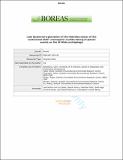Files in this item
Late Quaternary glaciation in the Hebrides sector of the continental shelf : cosmogenic nuclide dating of glacial events on the St Kilda archipelago
Item metadata
| dc.contributor.author | Ballantyne, Colin K. | |
| dc.contributor.author | Fabel, Derek | |
| dc.contributor.author | Gheorghiu, Delia | |
| dc.contributor.author | Rodés, Ángel | |
| dc.contributor.author | Shanks, Richard | |
| dc.contributor.author | Xu, Sheng | |
| dc.date.accessioned | 2018-04-25T23:33:35Z | |
| dc.date.available | 2018-04-25T23:33:35Z | |
| dc.date.issued | 2017-10 | |
| dc.identifier | 249811601 | |
| dc.identifier | 32f8f27e-2cc9-4230-89f3-48292286c7cf | |
| dc.identifier | 85018789165 | |
| dc.identifier | 000412097800001 | |
| dc.identifier.citation | Ballantyne , C K , Fabel , D , Gheorghiu , D , Rodés , Á , Shanks , R & Xu , S 2017 , ' Late Quaternary glaciation in the Hebrides sector of the continental shelf : cosmogenic nuclide dating of glacial events on the St Kilda archipelago ' , Boreas , vol. 46 , no. 4 , pp. 605-621 . https://doi.org/10.1111/bor.12242 | en |
| dc.identifier.issn | 1502-3885 | |
| dc.identifier.other | Bibtex: urn:26d95a081dd403ae48762588b038e155 | |
| dc.identifier.uri | https://hdl.handle.net/10023/13226 | |
| dc.description | The authors thank NERC-CIAF for funding analysis of the 10Be and 36Cl exposure ages (Allocation 9116/0412), the Carnegie Trust for the Universities of Scotland for a grant towards travel expenses. | en |
| dc.description.abstract | The St Kilda archipelago lies ~65 km west of the Outer Hebrides and ~60 km east of the Atlantic shelf break, and represents a key site for testing the assertion that during the Last Local Glacial Maximum (LLGM; c. 27 ka) the British–Irish Ice Sheet (BIIS) extended to near the shelf edge in all sectors. Two consistent cosmogenic 36Cl exposure ages averaging (≥) 81.6±7.8 ka for perched boulders at 290 m altitude demonstrate that the last ice sheet failed to over-run high ground on the largest island, Hirta. 36Cl and 10Be exposure ages for glacially emplaced boulders on low ground indicate deposition by small, locally nourished glaciers that last occupied a north-facing valley (Gleann Mòr) at c. 30.9±3.2 ka, prior to extension of the last ice sheet to the outer shelf, and a south-facing valley (Village Bay) at c. 19.2±2.3 ka, several millennia after the LLGM. Our dating evidence is consistent with previous interpretations of lithostratigraphical, seismostratigraphical and geomorphological evidence and confirms that the last ice sheet failed to encroach on St Kilda. A simple ice-flow model demonstrates that even if thin, low-gradient ice lobes encircled the archipelago during the LLGM, the ice margin can only have reached the outermost moraine banks, ~40 km west of St Kilda, under extremely low (<2 kPa) driving stresses, implying either surge-like transient streaming behaviour at the ice-sheet margin or that the moraine banks relate to an earlier, more extensive ice sheet. The final glaciation of the Village Bay area at c. 19.2±2.3 ka was out of phase with the behaviour of the BIIS, which was undergoing net retreat during this period. | |
| dc.format.extent | 2307731 | |
| dc.language.iso | eng | |
| dc.relation.ispartof | Boreas | en |
| dc.subject | GE Environmental Sciences | en |
| dc.subject | NDAS | en |
| dc.subject.lcc | GE | en |
| dc.title | Late Quaternary glaciation in the Hebrides sector of the continental shelf : cosmogenic nuclide dating of glacial events on the St Kilda archipelago | en |
| dc.type | Journal article | en |
| dc.contributor.institution | University of St Andrews. School of Geography and Geosciences | en |
| dc.contributor.institution | University of St Andrews. School of Geography & Sustainable Development | en |
| dc.identifier.doi | https://doi.org/10.1111/bor.12242 | |
| dc.description.status | Peer reviewed | en |
| dc.date.embargoedUntil | 2018-04-25 |
This item appears in the following Collection(s)
Items in the St Andrews Research Repository are protected by copyright, with all rights reserved, unless otherwise indicated.

